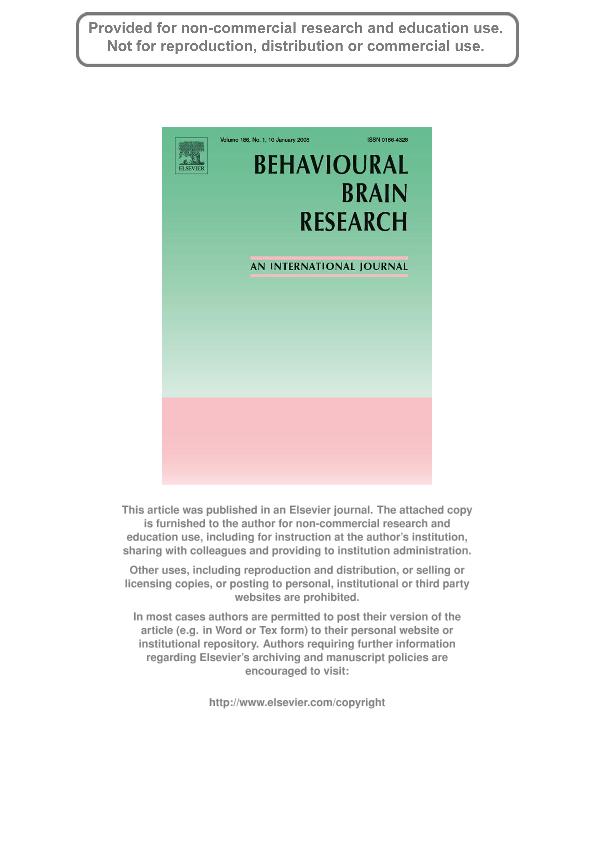Mostrar el registro sencillo del ítem
dc.contributor.author
Alvarez Toro, Edgardo Orozimbo

dc.contributor.author
Alvarez, Pablo A.
dc.date.available
2021-04-15T12:45:33Z
dc.date.issued
2008-12
dc.identifier.citation
Alvarez Toro, Edgardo Orozimbo; Alvarez, Pablo A.; Motivated exploratory behaviour in the rat: the role of hippocampus and the histaminergic neurotransmission; Elsevier Science; Behavioural Brain Research; 186; 1; 12-2008; 118-125
dc.identifier.issn
0166-4328
dc.identifier.uri
http://hdl.handle.net/11336/130096
dc.description.abstract
Exploration is one of most basic adaptive behavioural responses, giving the animal an important evolutionary advantage to survive in a changing environment. Inspection of novel environments might be come with motivated exploratory behaviour. In spite that this type of exploration in the rat is known for many years, little attention has been given to the intrinsic mechanisms or the brain structures that are involved in. In the present work the hippocampus, the neurotransmitter histamine, and the geometrical features of novel objects were examined in a model of conflictive and non-conflictive exploration in the rat which evaluates incentive-motivated exploration. Young adult intact rats were tested in a neutral non-conflictive behavioural activity detector (OVM), with (eOVM) or without (sOVM) novel objects. Three different objects were used: a box, a toy duck, and a tower. Results show that animals decrease its general motor activity (horizontal, ambulatory and non-ambulatory activity) in favor to exploration of the objects. Motivated exploration was not the same for all three objects. Rats explored significantly more the Tower and the Box objects than the Duck item. Behavioral patterns of hippocampus-implanted rats showed decreased scores in motor activity but maintained the difference in the relation of "without/with objects" exploration. When hippocampus-implanted rats were tested in a conflictive exploration device (the elevated asymmetric plus-maze), exploration of the No Wall arm, considered the most fear-inducing environment, was significantly more explored by the animal when the tower object was positioned at its end than when it was absent. Microinjection into the ventral hippocampus of histamine abolished this motivated exploratory response. Pre-treatment with pyrilamine, and not with ranitidine, was effective to block the inhibitory effect of histamine on the object motivated exploration. Results confirm that the hippocampus is involved on incentive motivated exploration, and suggest that histamine is part of an analyzing neuronal circuit of novelty incentivating behavioural responses in rats.
dc.format
application/pdf
dc.language.iso
eng
dc.publisher
Elsevier Science

dc.rights
info:eu-repo/semantics/openAccess
dc.rights.uri
https://creativecommons.org/licenses/by-nc-sa/2.5/ar/
dc.subject
ELEVATED ASYMMETRIC PLUS-MAZE
dc.subject
EXPLORATORY MOTIVATION
dc.subject
H1-HISTAMINE RECEPTORS
dc.subject
HIPPOCAMPUS
dc.subject
HISTAMINE
dc.subject
INCENTIVATING OBJECTS
dc.subject
NOVELTY
dc.subject.classification
Otras Ciencias Médicas

dc.subject.classification
Otras Ciencias Médicas

dc.subject.classification
CIENCIAS MÉDICAS Y DE LA SALUD

dc.title
Motivated exploratory behaviour in the rat: the role of hippocampus and the histaminergic neurotransmission
dc.type
info:eu-repo/semantics/article
dc.type
info:ar-repo/semantics/artículo
dc.type
info:eu-repo/semantics/publishedVersion
dc.date.updated
2021-02-03T13:26:04Z
dc.journal.volume
186
dc.journal.number
1
dc.journal.pagination
118-125
dc.journal.pais
Países Bajos

dc.journal.ciudad
Amsterdam
dc.description.fil
Fil: Alvarez Toro, Edgardo Orozimbo. Consejo Nacional de Investigaciones Científicas y Técnicas. Centro Científico Tecnológico Conicet - Mendoza. Instituto de Medicina y Biología Experimental de Cuyo; Argentina. Universidad Nacional de Cuyo. Facultad de Ciencias Médicas. Cátedra de Farmacología; Argentina
dc.description.fil
Fil: Alvarez, Pablo A.. Universidad Nacional de Cuyo. Facultad de Ciencias Médicas. Cátedra de Farmacología; Argentina
dc.journal.title
Behavioural Brain Research

dc.relation.alternativeid
info:eu-repo/semantics/altIdentifier/doi/http://dx.doi.org/10.1016/j.bbr.2007.07.038
Archivos asociados
